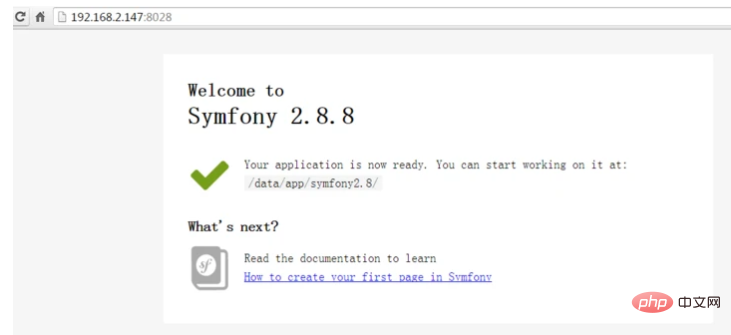下面由linux系統(tǒng)教程欄目給大家介紹Linux如何安裝Symfony2.8,希望對(duì)需要的朋友有所幫助!
環(huán)境說明
操作系統(tǒng)
tony@ubuntu:~$ lsb_release -a No LSB modules are available. Distributor ID: Ubuntu Description: Ubuntu 14.04.2 LTS Release: 14.04 Codename: trusty
Symfony
symfony2.8
安裝準(zhǔn)備
均使用 apt-get 安裝
PHP5.4
至少要有個(gè)PHP5.4的環(huán)境
nginx
web server 是少不了了
安裝步驟
1.下載官方命令工具
sudo curl -LsS https://symfony.com/installer -o /usr/local/bin/symfony sudo chmod a+x /usr/local/bin/symfony
2.創(chuàng)建項(xiàng)目
這里執(zhí)行項(xiàng)目創(chuàng)建時(shí),會(huì)從官網(wǎng)下載源碼包,執(zhí)行完后就能在當(dāng)前目錄看到了
symfony new symfony2.8 2.8
這里我創(chuàng)建了一個(gè)新的項(xiàng)目叫symfony2.8, 最后的2.8(不是項(xiàng)目名字中的2.8) 是要下載指定的symfony2.8版本的源碼,如果要下載的是其他版本, 修改一下接口
3.檢測(cè)
在安裝完后, symfony還會(huì)進(jìn)行一些檢測(cè), 看看你的操作系統(tǒng)環(huán)境是否適合運(yùn)行symfony, 按照提示將缺失的擴(kuò)展安裝(我安裝了intl)或者將PHP的配置修改(我就改了時(shí)區(qū)),再執(zhí)行
php symfony2.8/bin/symfony_requirements
再次檢測(cè)是否通過(php 后面的文件就在新創(chuàng)建的項(xiàng)目中,我這里項(xiàng)目名是symfony2.8)
運(yùn)行
symfony2.8' 自帶的console(位置symfony2.8/bin/console)可以臨時(shí)啟動(dòng)一個(gè)webserver,默認(rèn)端口是8000,啟動(dòng)后,通過http://localhost:8000` 就能看到他的歡迎頁(yè)面了
nginx 配置
nginx 的配置其官方文檔里也有, 這里直接把我的復(fù)制過來(lái),我也是直接修改的官方文檔
server { listen 8028; #server_name domain.tld www.domain.tld; root /data/app/symfony2.8/web; location / { # try to serve file directly, fallback to app.php try_files $uri /app.php$is_args$args; } # DEV # This rule should only be placed on your development environment # In production, don't include this and don't deploy app_dev.php or config.php location ~ ^/(app_dev|config).php(/|$) { fastcgi_pass 127.0.0.1:9000; fastcgi_split_path_info ^(.+.php)(/.*)$; include fastcgi_params; # When you are using symlinks to link the document root to the # current version of your application, you should pass the real # application path instead of the path to the symlink to PHP # FPM. # Otherwise, PHP's OPcache may not properly detect changes to # your PHP files (see https://github.com/zendtech/ZendOptimizerPlus/issues/126 # for more information). fastcgi_param SCRIPT_FILENAME $realpath_root$fastcgi_script_name; fastcgi_param DOCUMENT_ROOT $realpath_root; } # PROD location ~ ^/app.php(/|$) { fastcgi_pass unix:/var/run/php5-fpm.sock; fastcgi_split_path_info ^(.+.php)(/.*)$; include fastcgi_params; # When you are using symlinks to link the document root to the # current version of your application, you should pass the real # application path instead of the path to the symlink to PHP # FPM. # Otherwise, PHP's OPcache may not properly detect changes to # your PHP files (see https://github.com/zendtech/ZendOptimizerPlus/issues/126 # for more information). fastcgi_param SCRIPT_FILENAME $realpath_root$fastcgi_script_name; fastcgi_param DOCUMENT_ROOT $realpath_root; # Prevents URIs that include the front controller. This will 404: # http://domain.tld/app.php/some-path # Remove the internal directive to allow URIs like this internal; } # return 404 for all other php files not matching the front controller # this prevents access to other php files you don't want to be accessible. location ~ .php$ { return 404; } error_log /data/log/nginx/symfony_error.log; access_log /data/log/nginx/symfony_access.log; }
需要注意的是, nginx中包含了一個(gè)在開發(fā)環(huán)境適用的配置和一個(gè)在生產(chǎn)環(huán)境適用的配置,在生產(chǎn)華景部署的時(shí)候, 一定不要講開發(fā)環(huán)境的配置帶上去了
配置好后, 重新reload nginx,我這里監(jiān)聽的是虛擬機(jī)的8028端口,通過訪問這個(gè)端口,也可以直接看到歡迎頁(yè)面

推薦學(xué)習(xí):《linux視頻教程》
 站長(zhǎng)資訊網(wǎng)
站長(zhǎng)資訊網(wǎng)